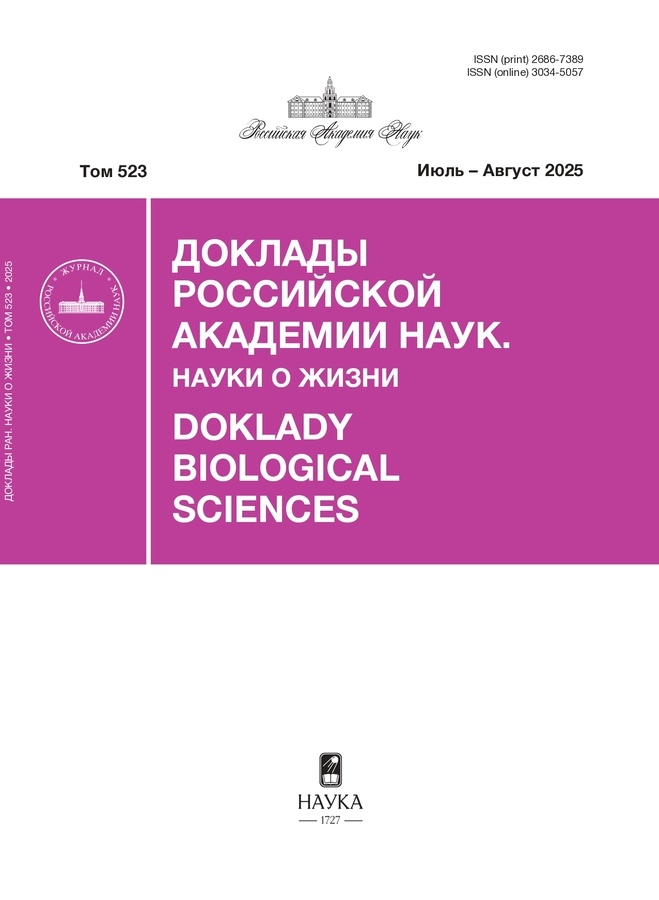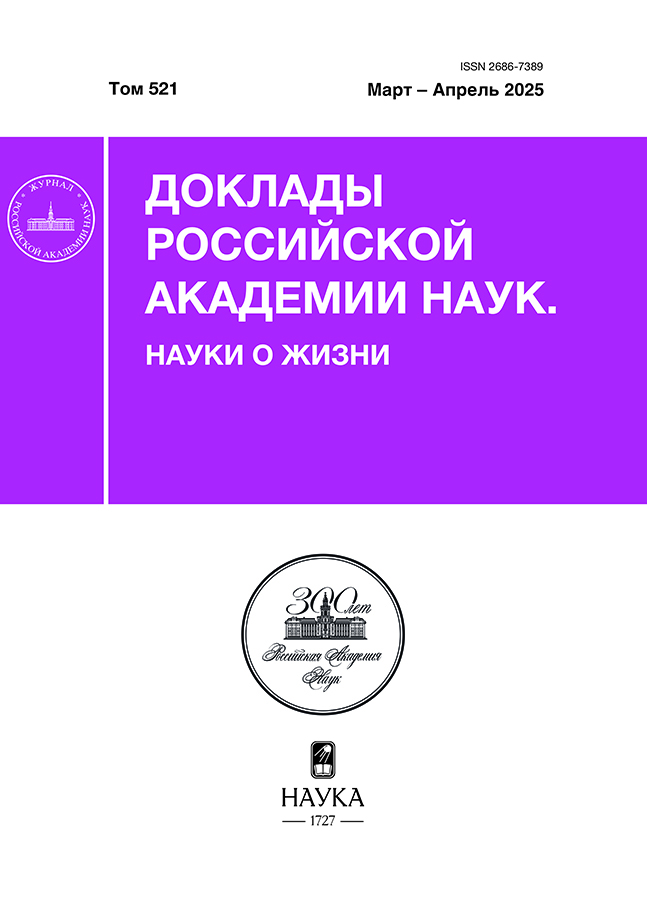Идентификация высоко консервативного района критичного для функциональности белка CP190 у Drosophila melanogaster
- Авторы: Мельникова Л.С.1, Балагуров К.И.1, Георгиев П.Г.1, Головнин А.К.1
-
Учреждения:
- Федеральное государственное бюджетное учреждение науки Институт биологии гена Российской академии наук (ИБГ РАН)
- Выпуск: Том 521, № 1 (2025)
- Страницы: 229-234
- Раздел: Статьи
- URL: https://cijournal.ru/2686-7389/article/view/684045
- DOI: https://doi.org/10.31857/S2686738925020115
- ID: 684045
Цитировать
Полный текст
Аннотация
Белок СP190 связывается как с промоторами генов домашнего хозяйства, так и с инсуляторными/граничными элементами и играет критическую роль в их активности. Целью работы являлось изучение влияния делеций в высоко консервативных районах белка CP190 на его функциональность. Показано, что делеция последовательности от 664 до 700 а.о. приводит к летальному фенотипу. Таким образом, в составе СР190 выявлен новый район, играющий важную роль во взаимодействии белка СР190 с еще не идентифицированными белками-партнерами, стабилизации формируемых СP190 белковых комплексов и рекрутировании их на хроматин.
Ключевые слова
Полный текст
Об авторах
Л. С. Мельникова
Федеральное государственное бюджетное учреждение науки Институт биологии гена Российской академии наук (ИБГ РАН)
Автор, ответственный за переписку.
Email: lsm73@mail.ru
Россия, Москва
К. И. Балагуров
Федеральное государственное бюджетное учреждение науки Институт биологии гена Российской академии наук (ИБГ РАН)
Email: lsm73@mail.ru
Россия, Москва
П. Г. Георгиев
Федеральное государственное бюджетное учреждение науки Институт биологии гена Российской академии наук (ИБГ РАН)
Email: lsm73@mail.ru
академик РАН
Россия, МоскваА. К. Головнин
Федеральное государственное бюджетное учреждение науки Институт биологии гена Российской академии наук (ИБГ РАН)
Email: lsm73@mail.ru
Россия, Москва
Список литературы
- Uyehara C.M., Apostolou E. 3D enhancer-promoter interactions and multi-connected hubs: Organizational principles and functional roles // Cell Rep. 2023. P. 112068.
- Karpinska M.A., Oudelaar A.M. The role of loop extrusion in enhancer-mediated gene activation // Curr Opin Genet Dev. 2023. V. 79. P. 102022.
- Serebreni L., Stark A. Insights into gene regulation: From regulatory genomic elements to DNA-protein and protein-protein interactions // Curr Opin Cell Biol. 2021. V. 70. P. 58–66.
- Vo Ngoc L., Kassavetis G.A., Kadonaga J.T. The RNA Polymerase II Core Promoter in Drosophila // Genetics. 2019. V. 212. № 1. P. 13–24.
- Kyrchanova O.V., Bylino O.V., Georgiev P.G. Mechanisms of enhancer-promoter communication and chromosomal architecture in mammals and Drosophila // Front Genet. 2022. V. 13. P. 1081088.
- Maharjan M., McKowen J.K., Hart C.M. Overlapping but Distinct Sequences Play Roles in the Insulator and Promoter Activities of the Drosophila BEAF-Dependent scs’ Insulator // Genetics. 2020. V. 215. № 4. P. 1003–1012.
- Bartkuhn M., Straub T., Herold M., et al. Active promoters and insulators are marked by the centrosomal protein 190 // EMBO J. 2009. V. 28. № 7. P. 877–88.
- Plevock K.M., Galletta B.J., Slep K.C., et al. Newly Characterized Region of CP190 Associates with Microtubules and Mediates Proper Spindle Morphology in Drosophila Stem Cells // PLoS One. 2015. V. 10. № 12. P. e0144174.
- Oliver D., Sheehan B., South H., et al. The chromosomal association/dissociation of the chromatin insulator protein Cp190 of Drosophila melanogaster is mediated by the BTB/POZ domain and two acidic regions // BMC cell biology. 2010. V. 11. P. 101.
- Bonchuk A., Balagurov K., Georgiev P. A structural view of evolution, multimerization, and protein-protein interactions // Bioessays. 2023. V. 45. № 2. P. e2200179.
- Sabirov M., Kyrchanova O., Pokholkova G.V., et al. Mechanism and functional role of the interaction between CP190 and the architectural protein Pita in Drosophila melanogaster // Epigenetics Chromatin. 2021. V. 14. № 1. P. 16.
- Kyrchanova O., Klimenko N., Postika N., et al. Drosophila architectural protein CTCF is not essential for fly survival and is able to function independently of CP190 // Biochim Biophys Acta Gene Regul Mech. 2021. V. 1864. № 10. P. 194733.
- Melnikova L., Kostyuchenko M., Molodina V., et al. Interactions between BTB domain of CP190 and two adjacent regions in Su(Hw) are required for the insulator complex formation // Chromosoma. 2018. V. 127. № 1. P. 59–71.
- Golovnin A., Melnikova L., Babosha V., et al. The N-Terminal Part of Drosophila CP190 Is a Platform for Interaction with Multiple Architectural Proteins // Int J Mol Sci. 2023. V. 24. № 21. P. 15917.
- Bag I., Chen S., Rosin L.F., et al. M1BP cooperates with CP190 to activate transcription at TAD borders and promote chromatin insulator activity // Nat Commun. 2021. V. 12. № 1. P. 4170.
- Bohla D., Herold M., Panzer I., et al. A functional insulator screen identifies NURF and dREAM components to be required for enhancer-blocking // PLoS One. 2014. V. 9. № 9. P. e107765.
- Kwon S.Y., Grisan V., Jang B., et al. Genome-Wide Mapping Targets of the Metazoan Chromatin Remodeling Factor NURF Reveals Nucleosome Remodeling at Enhancers, Core Promoters and Gene Insulators // PLoS Genet. 2016. V. 12. № 4. P. e1005969.
- Ali T., Krüger M., Bhuju S., et al. Chromatin binding of Gcn5 in Drosophila is largely mediated by CP190 // Nucleic Acids Res. 2017. V. 45. № 5. P. 2384–2395.
- Chen S., Rosin L.F., Pegoraro G., et al. NURF301 contributes to gypsy chromatin insulator-mediated nuclear organization // Nucleic Acids Res. 2022. V. 50. № 14. P. 7906–7924.
- Butcher R.D., Chodagam S., Basto R., et al. The Drosophila centrosome-associated protein CP190 is essential for viability but not for cell division // Journal of cell science. 2004. V. 117. № Pt 7. P. 1191–9.
Дополнительные файлы














